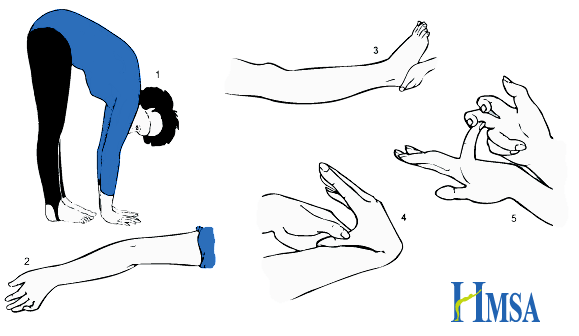Hypermobility
– with thanks to Dr Joe Ward, paediatric registrar at Whipps Cross University Hospital.
 |
Picture from Hypermobility Syndromes Association
Hypermobility = synovial joints moving beyond normal range of movement.
Defined by the Beighton Score.: 1,2
- Ability to touch palms flat to floor with knees straight (one point)
- Elbow extension >10° (one point for each side)
- Knee extension >10° (one point for each side)
- Ability to touch thumb to forearm (one point for each side)
- Fifth finger metocarpalphalageal joint extension >90° (one point for each side)
Scores of 4 or above indicate Generalised Joint Hypermobility. May be asymptomatic, or associated with joint pain (exacerbated by exercise), dislocations and fatigue. Chronic pain often leads to muscle weakness. Other associations include dizziness and syncope and gastrointestinal problems such as chronic abdominal pain and constipation.
Physiotherapy and exercises to strengthen muscles around hypermobile joints provide the mainstay of treatment. Exercises to improve balance and coordination may also be helpful as proprioception may be impaired. Occupational therapy input may be beneficial.
The Brighton Criteria (NB: Brighton, not Beighton) is used in adults to diagnose Joint Hypermobility Syndrome. To make the diagnosis you need one of: two major criteria; one major and two minor criteria; four minor criteria; two minor criteria and one affected first degree relative. The presence of an underlying syndrome excludes the diagnosis. It is not yet validated in children.
Major Criteria:
- Beighton Score >3
- Arthralgia > 3 months in four or more joints
Minor Criteria:
- Beighton Score 1-3,
- Arthralgia > 3 months in one joint, backpain, or spondylosis / spondylolysis / spondylolisthesis
- Dislocation or subluxation in more than one joint, or in one joint repeatedly
- Three or more soft tissue lesions (e.g epicondylitis, tenosynovitis, bursitis)
- Marfanoid habitus
- Skin striae
- Ocular signs (e.g drooping eyelids, myopia, antimongoloid slant)
- Varicose veins, hernia, uterine or rectal prolapse
- Mitral valve prolapse
Connective tissue disorders associated with hypermobility should be excluded amongst children who meet the criteria for Joint Hypermobility Syndrome. These include but are not limited to:
Ehlers-Danlos Syndrome (http://www.ehlers-danlos.org/) – Heterogeneous group of disorders involving skin laxity, joint hypermobility, and vascular complications. Defined by the Villefranche Classification.
Marfan’s Syndrome (http://www.marfan.org/about/marfan) – Autosomal dominant connective tissue disorder. Typical features include characteristic facies, joint laxity, musculoskeletal problems (bone overgrowth and disproportionately long limbs), lens dislocation, and cardiovascular complications including aortic root dilatation.
Further information:
References:
1. Cattalini, M., Khubchandani, R. & Cimaz, R. When flexibility is not necessarily a virtue: a review of hypermobility syndromes and chronic or recurrent musculoskeletal pain in children. Pediatr. Rheumatol. Online J. 13, (2015).
2. Pacey, V., Tofts, L., Wesley, A., Collins, F. & Singh-Grewal, D. Joint hypermobility syndrome: a review for clinicians. J. Paediatr. Child Health 51, 373–380 (2015).
Thanks for this.
The Beighton score is used in adults. In children, use with caution and some paediatric rheumatologists prefer not to use it as it is quite a crude screening tool. The Beighton score only assesses certain parts of the body. Some patients may have a specific hypermobile joint but overall their Beighton score is OK. E.g. a child has very hypermobile knees and complains of bilateral knee pain. All his other joints are normal, not hypermobile, so his Beighton score is 0. He may still have pain though and will still benefit from some physiotherapy input.
John Ho